A manual transmission stuck in gear can strand drivers, posing safety risks and causing frustration; Understanding its causes and solutions is crucial for timely resolutions and safe driving.
1.1 Understanding the Issue of a Manual Transmission Stuck in Gear
A manual transmission stuck in gear occurs when the gearbox fails to disengage from the current gear or shift to another. This issue prevents smooth gear transitions, making driving difficult or impossible. It can happen due to mechanical faults within the transmission system, such as worn components or fluid-related problems. When a gear is stuck, the driver may experience resistance or complete inability to change gears, leading to loss of vehicle control. This situation is not only frustrating but also potentially dangerous, as it can cause unexpected stops or acceleration. Understanding the mechanics behind this problem is crucial for effective troubleshooting and resolution.

1.2 Why It’s Important to Address the Problem
Addressing a manual transmission stuck in gear is crucial for maintaining vehicle safety and performance. Ignoring the issue can lead to further mechanical damage, increasing repair costs. A malfunctioning transmission can cause sudden stalling or inability to accelerate, posing serious safety risks, especially in traffic. Additionally, prolonged driving with a stuck gear can damage other components like the engine or driveshaft, reducing fuel efficiency and overall vehicle reliability. Regular maintenance helps prevent such issues, ensuring smooth operation and compliance with regulations, while also preserving the car’s resale value. Prompt action is essential to avoid more severe consequences.
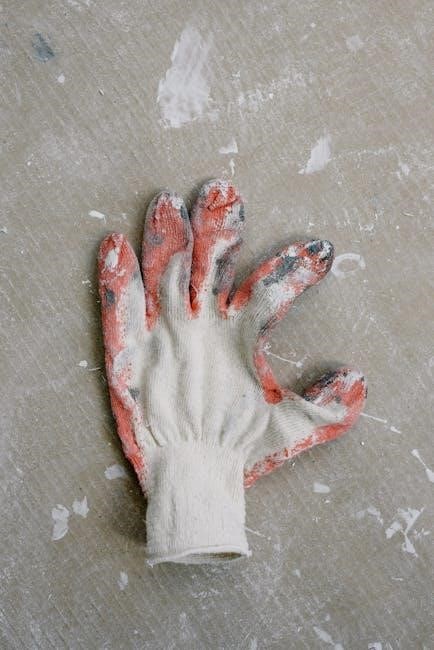
Common Causes of a Manual Transmission Stuck in Gear
A manual transmission can get stuck in gear due to low transmission fluid levels, a malfunctioning clutch, worn or damaged synchronizers, or issues with the shifter mechanism.
2.1 Low Transmission Fluid Levels
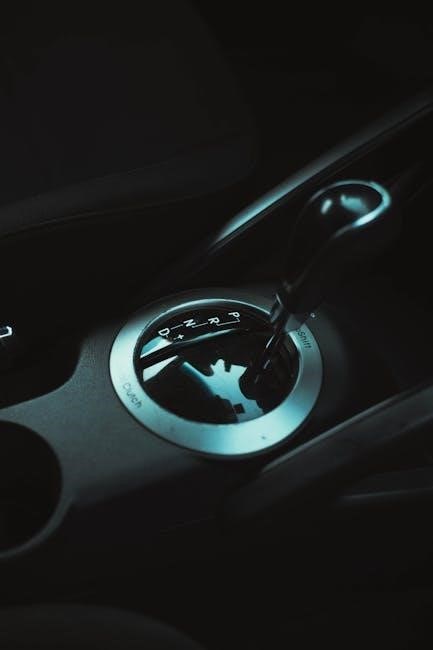
Low transmission fluid levels are a common cause of a manual transmission getting stuck in gear. Transmission fluid acts as a hydraulic medium and lubricant, ensuring smooth gear engagement. If fluid levels drop, the synchronizers cannot function properly, leading to gears sticking. This issue often arises due to leaks in the transmission pan, seals, or lines. Additionally, infrequent fluid changes can cause the fluid to degrade, reducing its effectiveness. Regular fluid checks and maintaining the recommended levels are crucial to prevent this problem. Always use the correct type of transmission fluid specified by the manufacturer. If unsure, consult the vehicle’s manual or a professional mechanic. Addressing low fluid levels promptly can prevent further damage and ensure smooth gear transitions.
2.2 Malfunctioning Clutch
A malfunctioning clutch is another common reason for a manual transmission getting stuck in gear. The clutch is responsible for disconnecting the engine from the transmission, allowing gears to shift smoothly. If the clutch fails to disengage properly, the gears cannot change, leaving the transmission stuck. This issue can arise from worn-out clutch components, incorrect clutch pedal adjustment, or damage to the clutch master or slave cylinders. A faulty clutch can also cause grinding noises during shifts. Addressing a malfunctioning clutch early is essential to prevent further damage to the transmission system. Regular inspection and maintenance of clutch components are recommended.
2.3 Worn or Damaged Synchronizers
Worn or damaged synchronizers are a common cause of a manual transmission getting stuck in gear. Synchronizers are responsible for ensuring smooth gear transitions by equalizing the speed of the gear and shaft during shifting. Over time, synchronizers can wear out due to heavy use, high mileage, or aggressive driving. When damaged, they fail to engage or disengage gears properly, leading to difficulty shifting or the transmission becoming stuck. Symptoms include grinding noises, difficulty shifting into specific gears, or the gear not engaging at all. Replacing worn synchronizers is often necessary to restore proper transmission function and prevent further damage.
2.4 Issues with the Shifter Mechanism
Issues with the shifter mechanism can cause a manual transmission to become stuck in gear. The shifter mechanism, including the shifter cables, linkages, and bushings, connects the gearshift to the transmission. Over time, these components can wear out or become misaligned, leading to improper engagement of gears. Symptoms include difficulty shifting, gears not aligning properly, or the shifter feeling loose. If the shifter mechanism fails, the transmission may remain in a specific gear, making it impossible to shift. Addressing these issues promptly is crucial to avoid further damage to the transmission system. Regular maintenance can help prevent such problems.
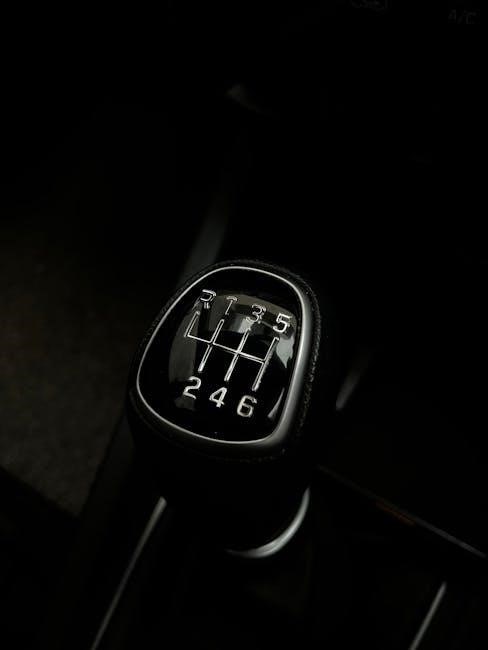
Symptoms of a Stuck Gear in Manual Transmission
Symptoms of a stuck gear include difficulty shifting, grinding noises during gear changes, and the vehicle stalling or refusing to move altogether.
3.1 Inability to Shift Gears Smoothly
One of the most noticeable symptoms of a stuck gear in a manual transmission is the inability to shift gears smoothly. This can manifest as stubborn resistance when attempting to move the shifter into the desired gear, or the gear may “catch” halfway through the shift. In some cases, the shifter may feel loose or unresponsive, making it difficult to engage gears properly. This issue can make driving unpredictable and challenging, especially in traffic or when accelerating from a standstill. If left unaddressed, it can lead to further damage to the transmission system.
3.2 Grinding or Noisy Gears
Grinding or noisy gears are common indicators of a manual transmission issue. This noise typically occurs when gears fail to engage smoothly, often due to worn synchronizers or insufficient lubrication. If the transmission fluid level is low or contaminated, it can prevent gears from meshing properly, leading to grinding sounds. Additionally, damaged or worn-out gear teeth can cause similar noises. It’s crucial to address this symptom promptly, as prolonged grinding can lead to further damage, such as chipped gears or synchronizer failure, resulting in costly repairs and potential transmission failure.
3.3 Car Stalling or Refusing to Move
When a manual transmission becomes stuck in gear, it can cause the car to stall or refuse to move. This often happens when the transmission fails to disengage properly from the current gear, preventing the engine from idling or the vehicle from accelerating. Issues like a malfunctioning clutch, low transmission fluid, or a faulty shifter mechanism can lead to this problem. If the car stalls, it may require restarting the engine or manually shifting into neutral to regain mobility. Ignoring this symptom can lead to further mechanical damage, emphasizing the need for prompt repair to restore proper transmission function.
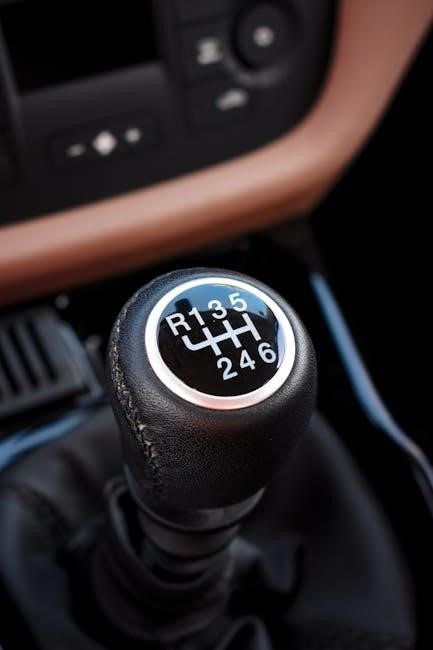
Troubleshooting and Diagnosis
Troubleshooting a stuck gear involves identifying the root cause through inspections and tests, such as checking fluid levels, clutch function, and shifter mechanics, and may require professional diagnostic tools.
4.1 Checking Transmission Fluid Levels
Checking transmission fluid levels is a critical first step in diagnosing a stuck gear issue. Low fluid levels can prevent proper lubrication, causing gears to stick or hesitate. Locate the transmission fluid dipstick, typically found under the hood, and wipe it clean before inserting it to get an accurate reading. If the level is below the recommended mark, add the specified fluid type. Signs of low fluid include grinding noises or difficulty shifting. Always consult your vehicle’s manual for specific instructions. If fluid levels are normal, further inspection of other components is necessary to identify the issue.
4.2 Inspecting the Clutch and Pressure Plate
Inspecting the clutch and pressure plate is essential when diagnosing a stuck gear issue. A malfunctioning clutch can prevent proper gear engagement, leading to gears sticking. Check for signs of wear, such as a spongy pedal or difficulty shifting. Visually inspect the clutch disc and pressure plate for damage or excessive wear. If the clutch is worn or misaligned, it may fail to disengage fully, causing gears to lock. Replace any damaged components and ensure proper alignment. Consult your vehicle’s manual or a mechanic for precise inspection and adjustment to restore smooth gear operation and prevent further issues.
4.3 Examining the Shifter Cables and Linkages
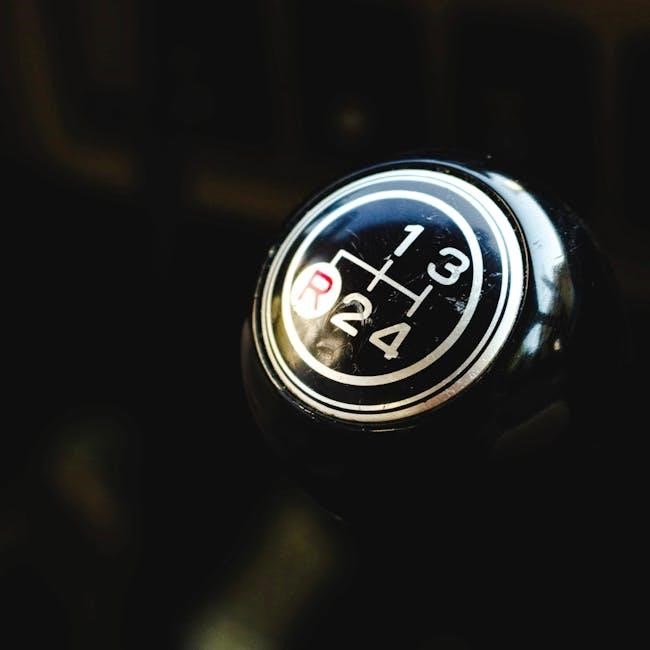
Examining the shifter cables and linkages is crucial for diagnosing gear sticking issues. These components connect the shifter to the transmission, ensuring proper gear engagement. Inspect the cables for signs of wear, fraying, or rust. Check linkages for looseness or misalignment. If the shifter feels loose or gears hesitate during shifts, the cables or linkages may be faulty. Lubricate moving parts and tighten loose connections. If damage is severe, replace the cables or linkages. Properly functioning shifter components are essential for smooth gear transitions and preventing the transmission from getting stuck in gear;
4.4 Professional Diagnosis by a Mechanic
A professional mechanic can provide an accurate diagnosis using specialized tools and expertise. They will inspect internal components like gear teeth, bearings, and the clutch system. Advanced diagnostic tools, such as transmission scanners and pressure testing equipment, help identify issues. Mechanics often perform test drives to replicate symptoms and assess shifting patterns. Their experience allows them to pinpoint problems that may not be obvious to DIYers. A professional diagnosis ensures repairs are targeted and effective, preventing further damage to the transmission or related systems. This step is critical for resolving stubborn or complex stuck-in-gear issues.
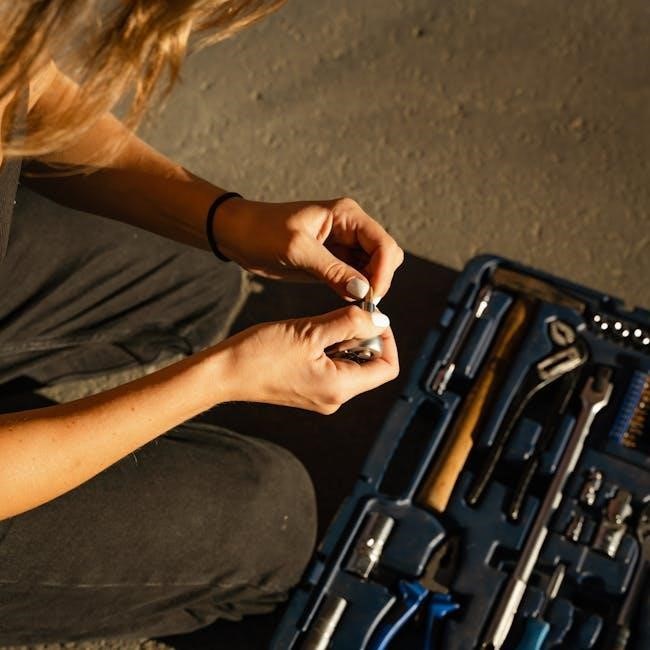
Solutions and Repairs
Addressing a stuck gear in a manual transmission often requires professional intervention. Solutions range from repairing damaged components to rebuilding or replacing the entire transmission. Timely repairs prevent further damage and ensure smooth operation.
5.1 Replacing the Clutch Kit
Replacing the clutch kit is a common solution for a manual transmission stuck in gear. A worn-out clutch can prevent proper gear disengagement, causing the transmission to lock in place. The process involves removing the old clutch, pressure plate, and bearing, then installing new components. It’s essential to ensure the flywheel is inspected and resurfaced if necessary. After replacement, the hydraulic system must be bled to eliminate air pockets. While this repair requires mechanical expertise, it effectively resolves gear-sticking issues and restores smooth shifting.
5.2 Adjusting or Replacing Shifter Cables
Shifter cables are critical for proper gear engagement. If they are loose, stretched, or damaged, they can prevent the transmission from shifting gears smoothly. Adjusting the shifter cables may resolve the issue by ensuring proper alignment and tension. However, if the cables are frayed or broken, replacement is necessary. This repair is relatively straightforward compared to other fixes, but it requires precision to ensure the cables are correctly calibrated. Regular inspection of shifter cables can prevent gear-sticking issues and maintain smooth transmission operation over time.
5.3 Repairing or Replacing Synchronizers
Synchronizers play a vital role in ensuring smooth gear transitions by equalizing the speed of the gear and shaft before engagement. When synchronizers become worn or damaged, gears may grind or refuse to shift, leading to a stuck-in-gear situation. Repairing or replacing synchronizers typically involves disassembling the transmission to access and replace the faulty components. This process can be complex and time-consuming, often requiring specialized tools and expertise. However, addressing this issue promptly prevents further damage to the transmission and restores proper shifting functionality. Regular maintenance can help identify worn synchronizers before they cause major problems.
5.4 Rebuilding or Replacing the Transmission
When damage to the manual transmission is severe, rebuilding or replacing it may be necessary. Rebuilding involves disassembling the transmission, inspecting, and replacing damaged or worn-out components, such as gears, bearings, and seals. This process requires specialized tools and expertise. In some cases, replacing the transmission entirely with a new or remanufactured unit is more cost-effective. Both options ensure proper gear engagement and smooth operation. While rebuilding is labor-intensive, it can be more affordable. Replacement, on the other hand, offers a quicker solution but at a higher upfront cost. Either way, addressing the issue is crucial to restoring the vehicle’s performance and reliability.

Preventive Maintenance
Regular maintenance is key to preventing gears from getting stuck. Check transmission fluid levels, inspect shifter linkages, and replace worn bushings. Avoid aggressive driving habits to reduce wear on components, ensuring smooth gear transitions and longevity of the manual transmission system. Early detection of issues prevents major repairs and keeps the vehicle running efficiently. Consistent care extends the lifespan of the transmission, saving time and money in the long run.
6.1 Regular Transmission Fluid Checks
Regular checks of transmission fluid levels are essential to prevent gears from sticking. Low fluid levels can cause inadequate lubrication, leading to friction and potential damage. Always use the type of fluid recommended by the manufacturer. If levels are low, top them up, but also inspect for leaks. The fluid’s condition matters too; dirty or degraded fluid should be replaced. Checking the fluid every 30,000 to 60,000 miles helps maintain smooth gear transitions and prevents costly repairs. A well-maintained transmission ensures optimal performance and longevity.
6.2 Inspecting Shifter Bushings and Linkages
Inspecting shifter bushings and linkages is crucial for maintaining smooth gear transitions. Worn or loose components can disrupt the connection between the shifter and transmission, leading to stuck gears. Regularly checking for wear, cracks, or excessive play helps identify issues early. Lubricating moving parts ensures proper function. Replacing damaged bushings or linkages promptly prevents further complications. This maintenance step is simple yet effective in avoiding gear-sticking problems and ensuring precise control over the transmission system.
6.3 Avoiding Aggressive Driving Practices
Avoiding aggressive driving practices is essential to prevent a manual transmission from getting stuck in gear. Rapid shifting, riding the clutch, or sudden acceleration can strain the synchronizers and gears, leading to premature wear. Smooth, deliberate shifts reduce stress on the transmission components. Aggressive driving can cause the gears to overheat or misalign, increasing the likelihood of sticking. By adopting a calm and controlled driving style, drivers can significantly reduce the risk of gear-related issues and extend the lifespan of their manual transmission system.
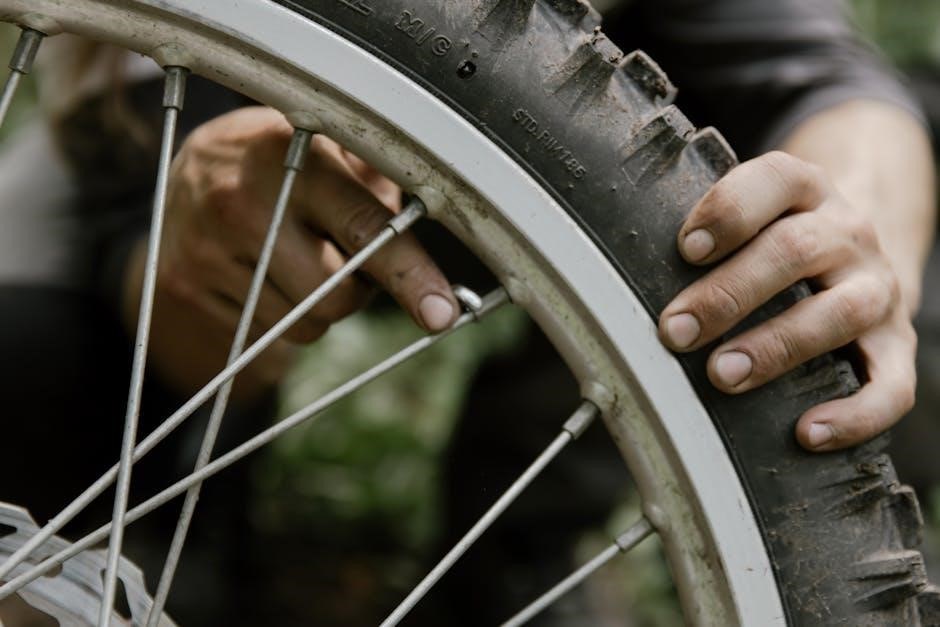
Case Studies and Real-Life Examples
Real-life examples highlight common scenarios where manual transmissions get stuck in gear. Drivers often report issues after aggressive driving or neglecting maintenance, leading to costly repairs.
7.1 Stuck in First Gear: A Common Issue
One prevalent scenario involves a manual transmission stuck in first gear, often due to low transmission fluid levels or a malfunctioning clutch. Drivers may experience difficulty shifting out of first gear, accompanied by grinding noises. This issue is frequently reported in high-mileage vehicles, where wear and tear on synchronizers and gear teeth exacerbate the problem. If left unaddressed, it can lead to costly repairs, such as replacing the entire transmission. Regular maintenance, including fluid checks and clutch inspections, is crucial to prevent this common issue from arising.
7.2 High Mileage Manual Transmissions and Gear Problems
High-mileage manual transmissions often experience gear-related issues due to wear and tear on components like bearings, seals, and synchronizers. Over time, these parts degrade, leading to stuck gears or difficulty shifting. Contaminated transmission fluid, which loses its lubricating properties, can exacerbate the problem. Symptoms include slipping gears, especially under load, and hesitation during acceleration. Regular fluid flushes and inspections can help mitigate these issues, but neglecting maintenance often results in costly repairs. Addressing these problems early is essential to extending the transmission’s lifespan and preventing further damage.
7.3 Manufacturer Recalls and Technical Service Bulletins
Many manufacturers have issued recalls or technical service bulletins (TSBs) related to manual transmissions stuck in gear. These often stem from design flaws or faulty components. For example, certain models may have issues with synchronizer rings or shifter mechanisms, leading to gear-sticking problems. Owners are advised to check their vehicle’s VIN for outstanding recalls and contact dealerships for free repairs. TSBs may also provide diagnostic and repair procedures for common issues, ensuring dealers can address problems effectively. Staying informed about these updates is crucial for maintaining transmission health and avoiding costly repairs down the line.
A stuck manual transmission is a serious issue requiring prompt attention. Addressing causes like low fluid, clutch problems, or worn parts is essential. Regular maintenance prevents such issues, ensuring smooth gear operation and extending transmission lifespan. Always seek professional help if problems persist to avoid further damage.
8.1 Summary of Key Points
A manual transmission stuck in gear is often caused by low fluid levels, a malfunctioning clutch, worn synchronizers, or shifter mechanism issues. Symptoms include difficulty shifting, grinding noises, and stalling. Regular maintenance, such as checking fluid levels and inspecting components, can prevent these problems. Addressing issues early avoids costly repairs and ensures smooth operation. Replacing damaged parts like the clutch or synchronizers may be necessary. Professional diagnosis is recommended for complex cases. Preventive care and timely repairs are crucial for maintaining transmission health and avoiding sudden failures while driving.
8.2 Importance of Regular Maintenance
Regular maintenance is crucial for preventing manual transmission issues like gears getting stuck. Checking transmission fluid levels, inspecting shifter cables, and replacing worn components can identify problems early. This proactive approach reduces the risk of sudden breakdowns and costly repairs. Maintaining the clutch and synchronizers ensures smooth shifting and extends the transmission’s lifespan. Neglecting routine care can lead to irreversible damage, emphasizing the need for consistent upkeep. Regular maintenance not only saves money but also enhances safety and reliability, keeping the vehicle running smoothly for years.